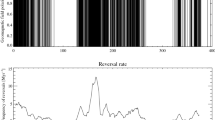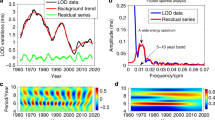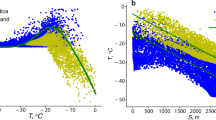Abstract
ACCORDING to Milankovitch theory1,2, the ice ages are related to variations of insolation in northern latitudes resulting from changes in the Earth's orbital and orientation parameters (precession, eccentricity and obliquity). Here we investigate the stability of the Earth's orientation for all possible values of the initial obliquity, by integrating the equations of precession of the Earth. We find a large chaotic zone which extends from 60° to 90° in obliquity. In its present state, the Earth avoids this chaotic zone and its obliquity is essentially stable, exhibiting only small variations of ± 1.3° around the mean value of 23.3°. But if the Moon were not present, the torque exerted on the Earth would be smaller, and the chaotic zone would then extend from nearly 0° up to about 85°. Thus, had the planet not acquired the Moon, large variations in obliquity resulting from its chaotic behaviour might have driven dramatic changes in climate. In this sense one might consider the Moon to act as a potential climate regulator for the Earth.
This is a preview of subscription content, access via your institution
Access options
Subscribe to this journal
Receive 51 print issues and online access
$199.00 per year
only $3.90 per issue
Buy this article
- Purchase on Springer Link
- Instant access to full article PDF
Prices may be subject to local taxes which are calculated during checkout
Similar content being viewed by others
References
Imbrie, J. Icarus 50, 408–422 (1982).
Berger, A., Imbrie, J., Hays, J., Kukla, G. & Saltzman, B. (eds) Milankovitch and Climate (Reidel, Dordrecht, 1984).
Ward, W. R. Icarus 50, 444–448 (1982).
Laskar, J. Icarus 88, 266–291 (1990).
Laskar, J., Froeschlé, C. & Celletti, A. Physica D 56, 253–269 (1992).
Laskar, J. Physica D (in the press).
Laskar, J., Joutel, F. & Boudin, F. Astr. Astrophys. (in the press).
Williams, G. E. J. Phys. Earth 38, 475–491 (1990).
Kinoshita, H. Celest. Mech. 15, 277–326 (1977).
Laskar, J. Astr. Astrophys. 157, 59–70 (1986).
Laskar, J. Nature 338, 237–238 (1989).
Laskar, J. in Chaos, Resonance and Collective Dynamical Phenomena in the Solar System (ed. Ferraz-Mello, S.) 1–16 (Kluwer, Dordrecht, 1992).
Laskar, J., Quinn, T. & Tremaine, S. Icarus 95, 148 (1992).
Sussman, G. & Wisdom, J. Science 257, 56–62 (1992).
Author information
Authors and Affiliations
Rights and permissions
About this article
Cite this article
Laskar, J., Joutel, F. & Robutel, P. Stabilization of the Earth's obliquity by the Moon. Nature 361, 615–617 (1993). https://doi.org/10.1038/361615a0
Received:
Accepted:
Issue Date:
DOI: https://doi.org/10.1038/361615a0
This article is cited by
-
Impact of a moon on the evolution of a planet’s rotation axis: a non-resonant case
Celestial Mechanics and Dynamical Astronomy (2022)
-
Analytical solution of the Colombo top problem
Celestial Mechanics and Dynamical Astronomy (2020)
Comments
By submitting a comment you agree to abide by our Terms and Community Guidelines. If you find something abusive or that does not comply with our terms or guidelines please flag it as inappropriate.



